Looking for a decent community platform?
You have Skool, Circle, Mighty Networks…
Among them all, Circle seems to be a solid pick. You have big guys like Ali Abdaal and Pat Flynn, on it right?
Here’s something interesting:
Also it’s actually backed by the founders of Teachable (more on this below👇)
In this review, I’ll share my experience with Circle.
What is Circle?

Circle is an all-in-one community platform designed for businesses, startups, community builders, and coaches.
It was launched in 2019 by Sid Yadav, who is Teachable’s first designer, and later backed by Ankur Nagpal (invested 90% of his liquid net-worth), the founder of Teachable.
With their support and track record, Circle quickly gained traction and raised additional funds (valued at $200M)!
Let’s get started.
Here’s a neat list of all their features:
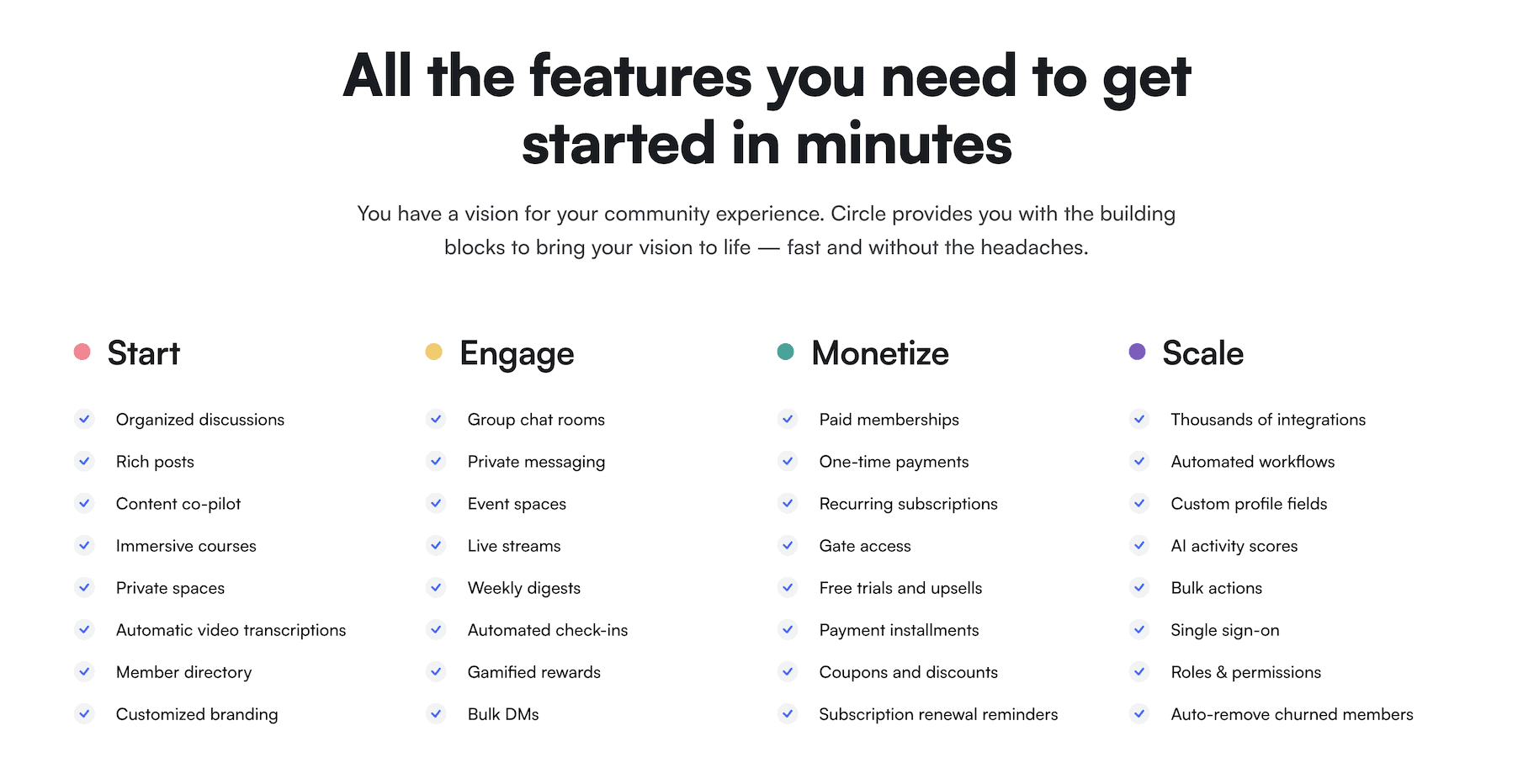
Take a moment and first please firstdigestthe above screenshot.
Now, let me help you decide:
Quick decision
What do I like about Circle.so? 👍
- Intuitive UI/UX: The interface is genuinely clean and modern – it feels like using Slack or Discord. Way less cluttered than Mighty Networks, which makes everything just flow better.
- Courses: You can host courses right alongside your community. If you’re a creator who wants to do both, this is perfect.
- Moderation tools: The spam prevention is solid – keyword blocklists, content flagging, all that good stuff. Really helps when you’re managing public groups.
- Mobile apps: Both iOS and Android apps work well. Your members can jump into the community, take courses, manage memberships – all from their phones.
- Live-streaming: Built right in, no extra tools needed. They just added live spaces too, so you can broadcast to specific groups.
- Automation workflows: This is honestly game-changing for managing your community. Automate tasks, do bulk actions – it’s basically Zapier built into Circle. Just note it’s only on the Business plan ($199/mo) and up.
- Email marketing: They’re trying to be a true all-in-one platform with their new marketing hub. Though heads up – it’s $100 per 10,000 subscribers as an add-on.
What I don’t like about Circle.so? 👎
- Hidden transaction fees: This frustrated me. They don’t show the 2% transaction fee upfront on their pricing page. So when you start processing payments, surprise! You’re paying 2% to Circle plus Stripe’s 2.9% + $0.30. That adds up fast.
- Automation locked behind expensive plan: Those amazing workflow automations and AI tools I mentioned? Yeah, they’re only on the Business plan at $199/mo minimum. Feels like they should be available earlier.
- Email marketing costs extra: Unlike Kajabi that includes everything, Circle makes you pay an extra $100 per 10,000 subscribers for email marketing. That’s on top of your base subscription.
- Limited LMS features:: No certifications, no advanced assessments. If you’re just sharing content with your community, you’re fine. But if you’re teaching something academic or need proper credentials, check out Thinkific or LearnWorlds instead.
And here’s the worst part:
Remember I told you, it is from the founders of Teachable?
They are following the same playbook (Teachable does this) 👇
👎 They don’t have any native integration with popular email marketing apps, forcing you to use either Zapier or their own email marketing addon.
Upfront bottom line
Honestly? I love using Circle. The UI and UX are just GOOD!
And let’s face it – community is where everything’s headed. Circle gets this.
They’re nailing it with an intuitive interface, powerful automation, and tons of integrations that make community management actually enjoyable. Plus, with their funding and how fast they’re shipping new features, they’re only getting better.
But here’s where things get frustrating – the email marketing situation.
While platforms like Kajabi give you everything in one package, Circle makes you pay an extra $100 per 10,000 subscribers for email marketing. And get this – they don’t have native integrations with email tools, so you’re basically forced to use Zapier.
👉 Overall, based on my hands-on experience, Circle is still a solid choice for those looking to build a thriving community and offer courses. Just be prepared to either pay extra for email marketing
Community
Interface and ease of use
You can think of Circle as a hybrid between Slack and online forums.

It has a sidebar-centric navigation similar to Slack.
As an avid user of Notion and Slack, this is really intuitive for me.

They also have a community switcher tool similar to new-age chat platforms like Discord. With just a single click, community members can quickly switch between multiple spaces.
So yeah, it’s be a really good feature for them to have for growth.
Organization
You can build communities that have:
- Groups: Collection of spaces, similar to a category or a folder.
- Spaces: It’s a feature like Slack channels or WhatsApp groups, serving as the platform for specific discussions or content.
You can create either public or private spaces.

When you create a space, it asks you to select the type of the Space.
As of now, there are 4 different types of spaces you can create like:
- Posts: Create and share content with your community (think of a forum).
- Events: Organize and manage live events for your members.
- Chat: Engage in real-time conversations with your community members.
- Course: Educate your audience.
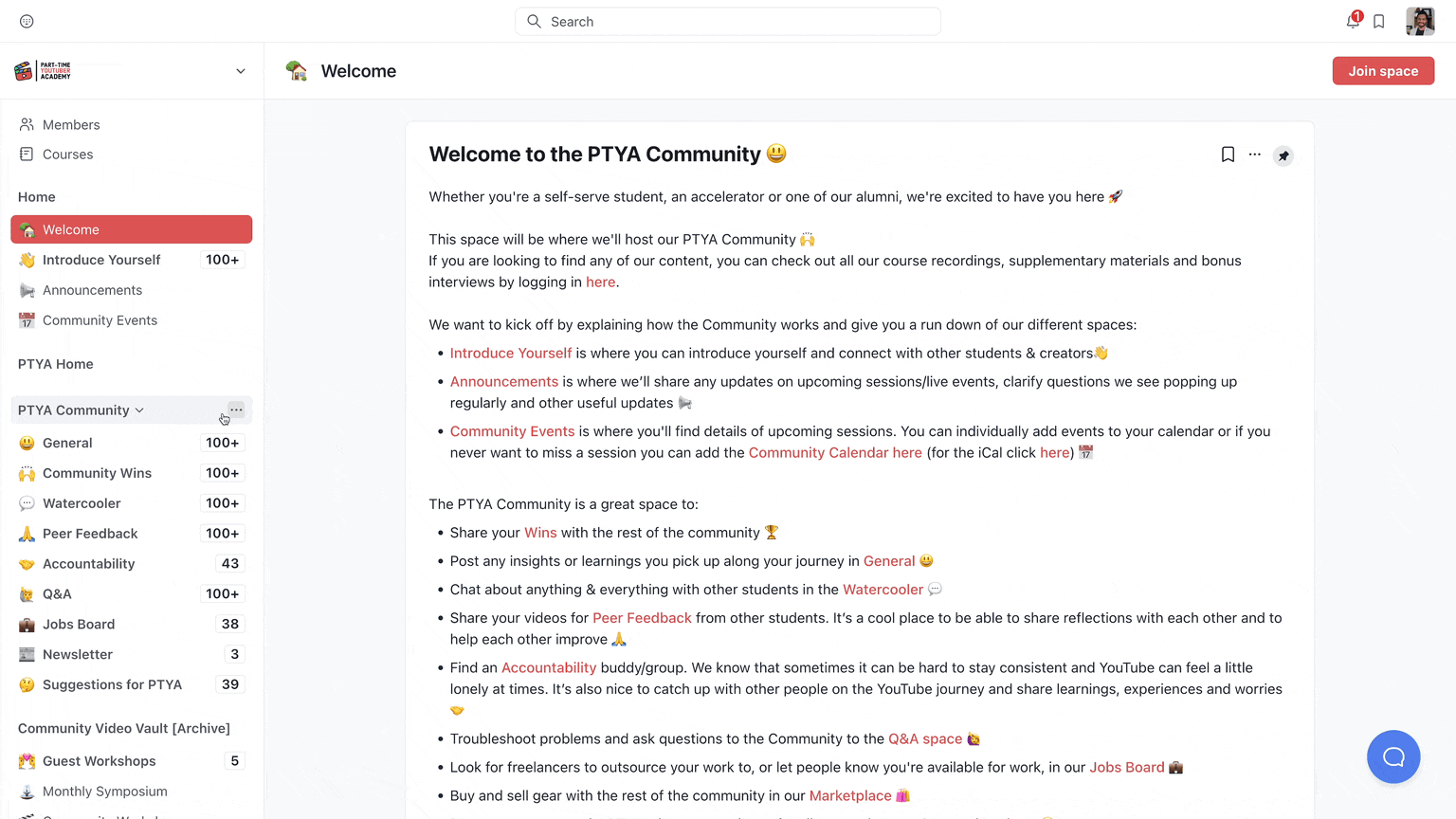
You can’t have multiple different content types inside a particular space
This leads to a lot of clutter in the sidebar.

You can enable the space content to be displayed in different layouts like:
- Post (suitable most of the times): Displays posts’ content in a scrollable feed
- List: Collapses posts to show only the title, the last post date, and like/comment counts
- Card: Posts are displayed in a grid showing the cover image
Posting content
In every space you create in Circle, you can create content.

The content that you create in each of the spaces can be further organized in folders to help you keep the content organized.

Now, when it comes to creating actual content, Circle features a fully featured editor that supports “/” commands.

Similar to Notion app, you can use any of these building blocks for creating content.
🤖 Also, they have AI co-pilot functionality that allows you to access ChatGPT like AI assistant right inside the post editor to speed up the content creation process.
I really like the attention to detail that Circle has given to its editor.
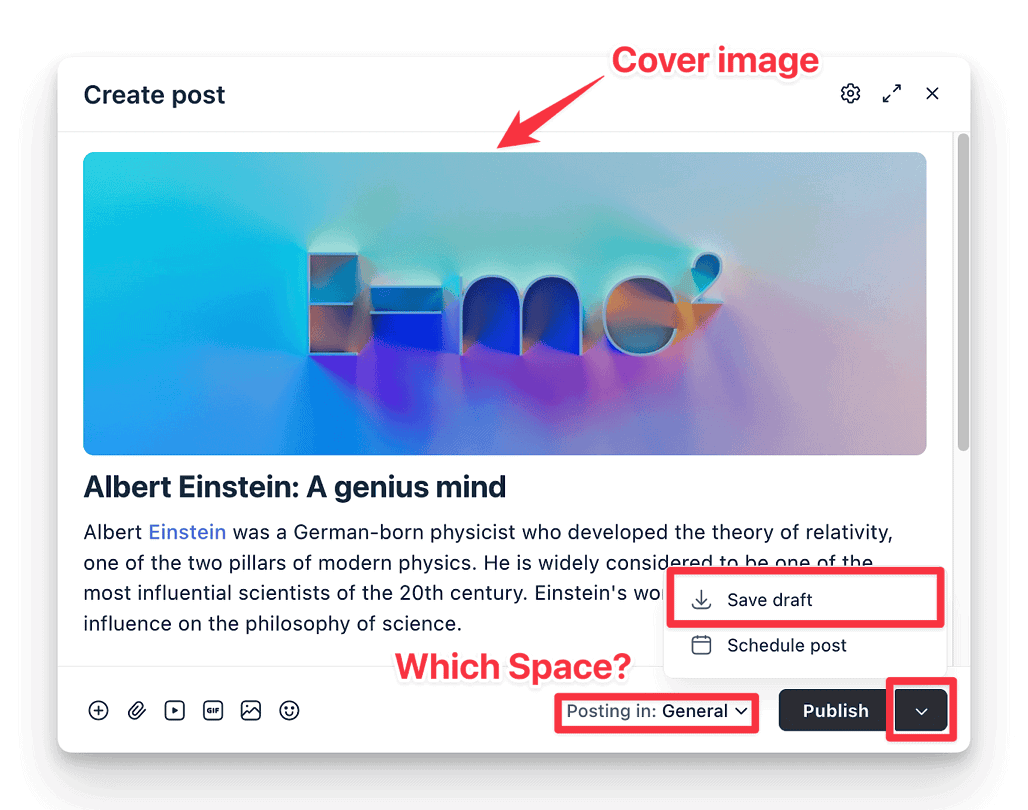
For instance, it comes with the ability to add a cover image for each post, which would be really helpful when you are writing an entire blog post or a tutorial inside of inside of Circle.
This is a really big benefit over other platforms, like say Mighty Networks, which only offer a basic content editor without any formatting options.
🤫 Pro tip: You can use the spaces functionality (with card-view layout) to host your training courses instead of spending additional money on Circle’s higher plans for course functionality.
Community access
Before creating content, you need to add people to your community space.
Let me explain.
With Circle, you have the ability to set certain spaces as private or secret and create paywalls for them.
This allows you to control access to the content within those spaces and charge for access.

So here’s a real example: say you want to create a “Pro” membership tier.
You’d set it up so Pro members get access to your exclusive spaces – maybe your advanced training modules or your VIP chat room.
Also, Circle lets you customize what happens right after someone purchases.
You can redirect them to a specific welcome page, trigger automations, or even add your own conversion tracking pixel if you’re running ads. Pretty handy for tracking your marketing ROI.

You also have an option to customize the login screen when a user tries to access the paywall space.
This is a conversion opportunity, prompting users to upgrade their membership.
Onboarding new users
In Circle, you have various options to customize the onboarding experience for new community members.
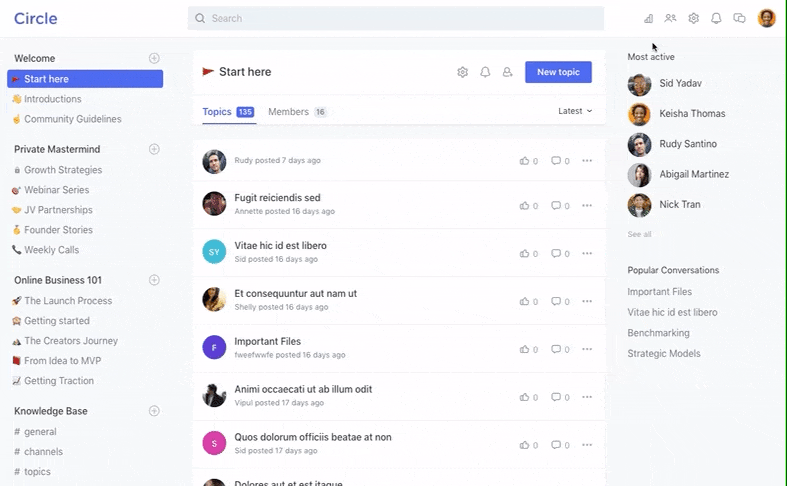
Head over to the settings and under onboarding, you can customize the invitation emails that will be sent to new members of the community.
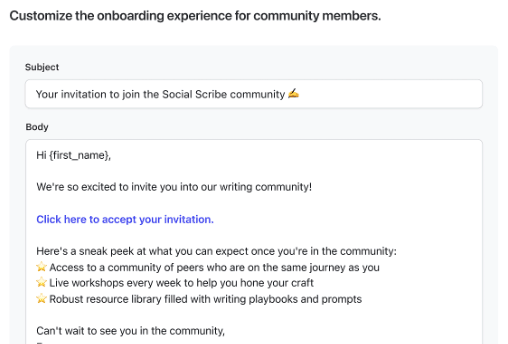
Circle offers custom invitation emails with variables for invitation/community URLs, separate email options for new and existing users, and customizable post-signup messages to welcome new members.
To take it further, you can use Circle’s automation workflows (available in their higher plan) to say:
- 📧 Automatically send a welcome message when a new member joins the community.
- 🚨 Notify admins when a new member joins the community.
- and more… 🚀
Apart from this feature, in Circle, you have the option to set default login pages for both existing and new members.
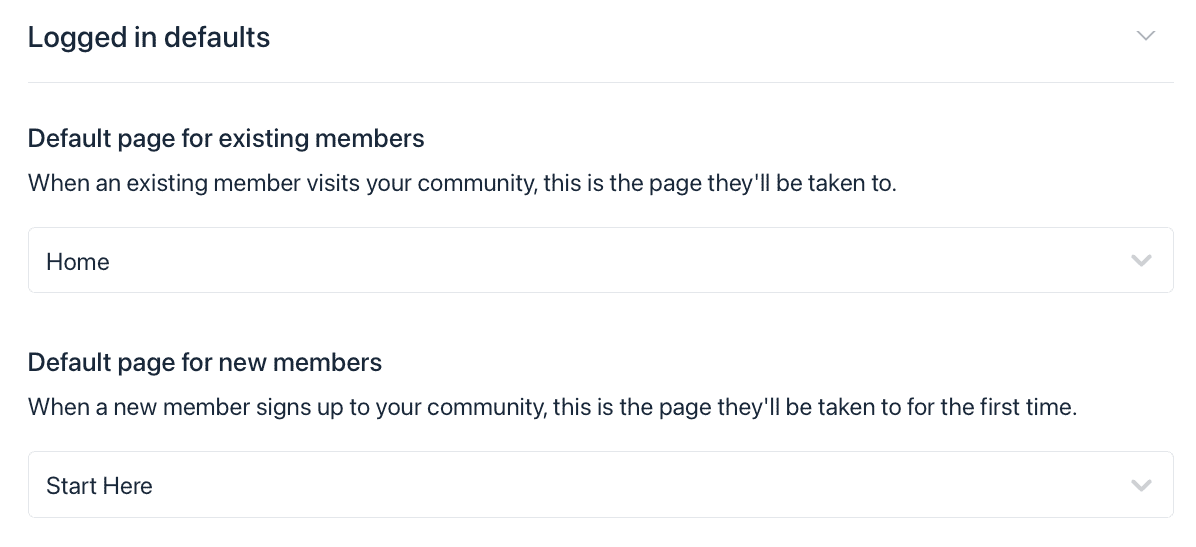
Upon joining the community, new members are automatically guided to the “Start Here” page, offering answers to FAQs and prompting self-introduction.
Also, you can direct returning members to the home page, providing a glimpse of recent community activities.
🏆 Bottom line: Circle offers an intuitive interface with Slack-like navigation and Discord-style community switching. It comes with spaces with 4 content types: Posts, Events, Chat, and Courses. The platform supports rich content creation with “/” commands and AI.
Events and livestreaming
Creating webinars or live office discussions really fosters a sense of community and encourages more active engagement.
Circle features built-in live-streaming for calls with up to 30 participants or events for up to 1,000 members.
You can create a dedicated space for these events within the community feature.
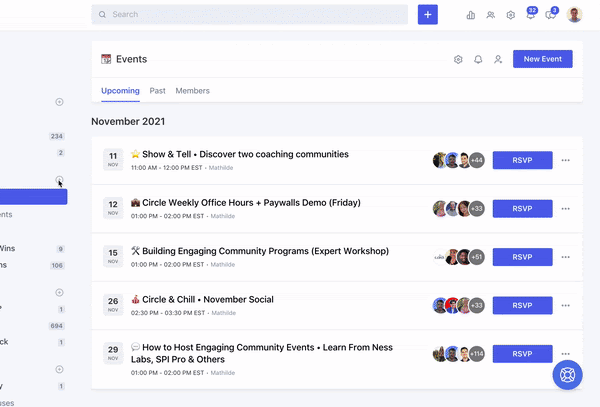
Within this space, you can create multiple events and schedule them.
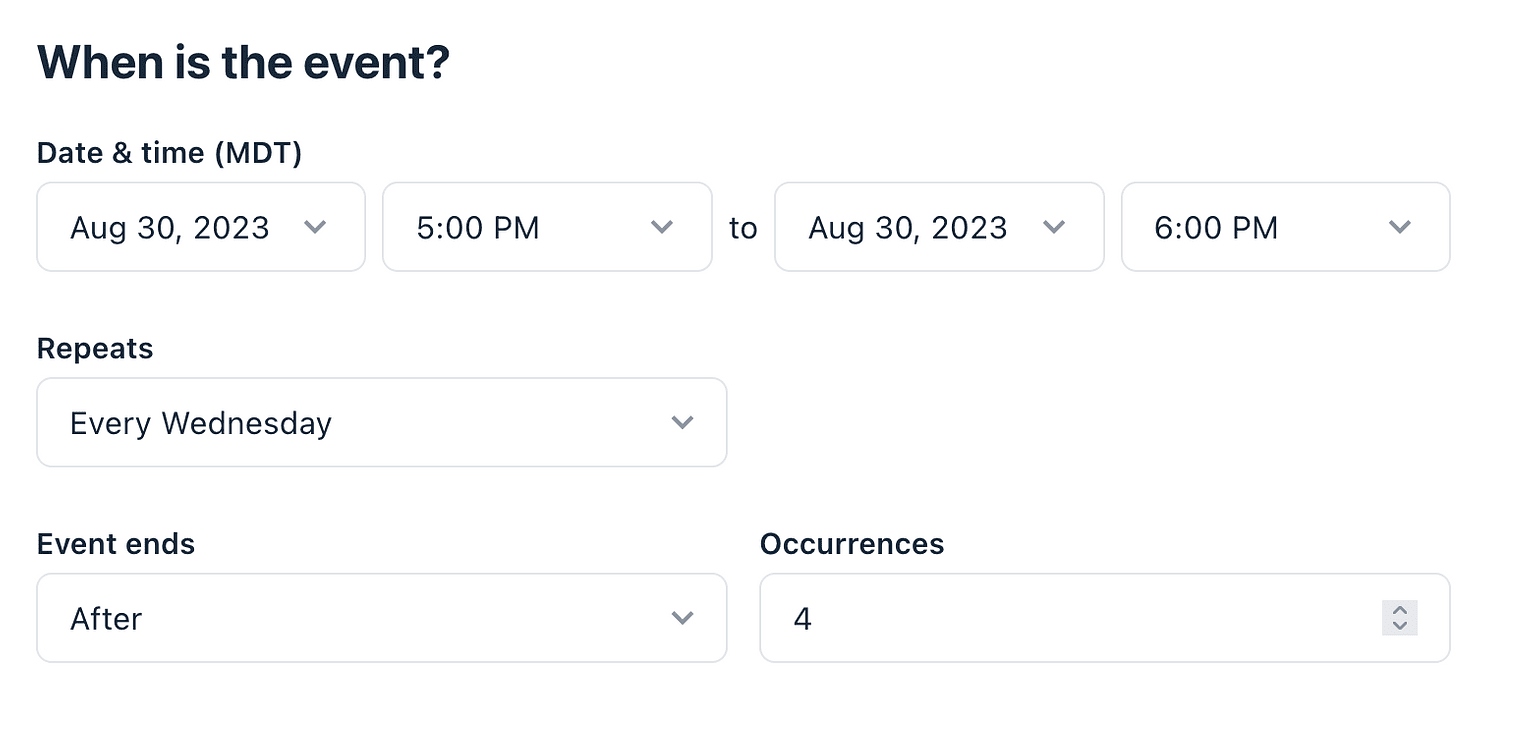
When creating an event, you can specify the date, time, duration, and even set it as a recurring event to avoid repetitive scheduling.
For example, on every Wednesday, if you have a weekly mastermind call, you can set it.
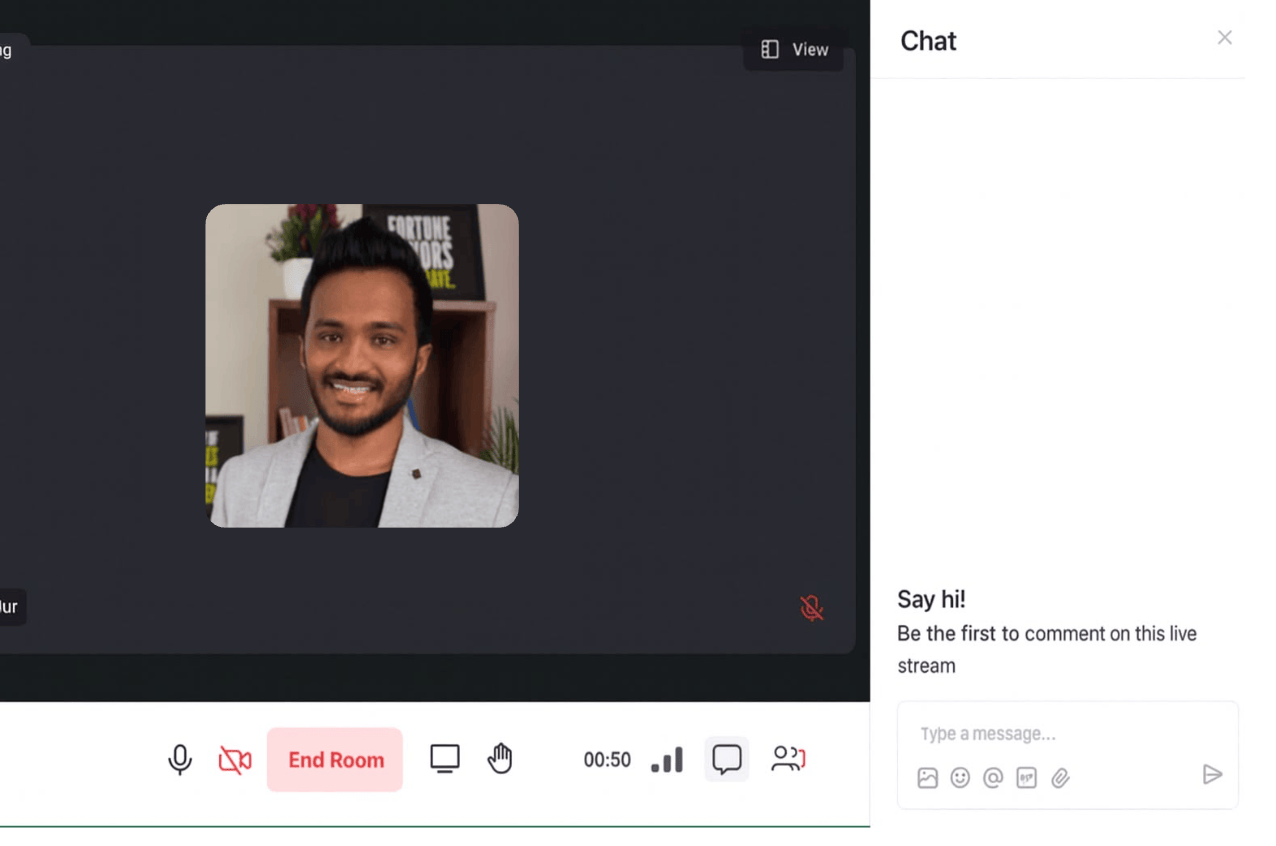
Also, when it comes to the location of the event, you can choose between Circle’s own live streaming feature (with recording feature), Zoom or Google Meet.
Now, I gotta be honest with you here:
If you’re running a content-heavy community with lots of videos and live events, the playback quality can be hit or miss. I’ve noticed the stream lags sometimes, which can be frustrating during important sessions.
And here’s another thing:
The mobile app experience? It’s honestly not great compared to using Circle on desktop or in a browser.
There have been times when I’ve just wanted to switch to Zoom or Google Meet, especially when dealing with limited internet or low bandwidth situations.
🏆 Bottom line: Circle’s event features include built-in livestreaming for up to 30 participants or 1,000 viewers, with scheduling options for one-time or recurring events. Integration with Zoom and Google Meet provides flexibility for various event formats.
Online courses
In 2023, Circle introduced a course feature with basic LMS capabilities.
❓ Did you know? The CEO of Teachable, Ankur Nagpal has 90% of his liquid net-worth invested in Circle!
Now.
To control the order in which students consume the content in training course, you can choose from three types of course spaces:
- Self-paced: Students have immediate access to all course content upon enrollment.
- Structured: Course sections are released gradually based on student enrollment.
- Scheduled: Each section is released on a specific date for all students according to a predetermined schedule.

The course curriculum is organized into sections and lessons, supporting text, audio/video, and embed codes.
Also, lectures can be drip-scheduled to prevent binge-watching.

When it comes to lesson content, you can include various building blocks like you would do with Notion for creating the content.
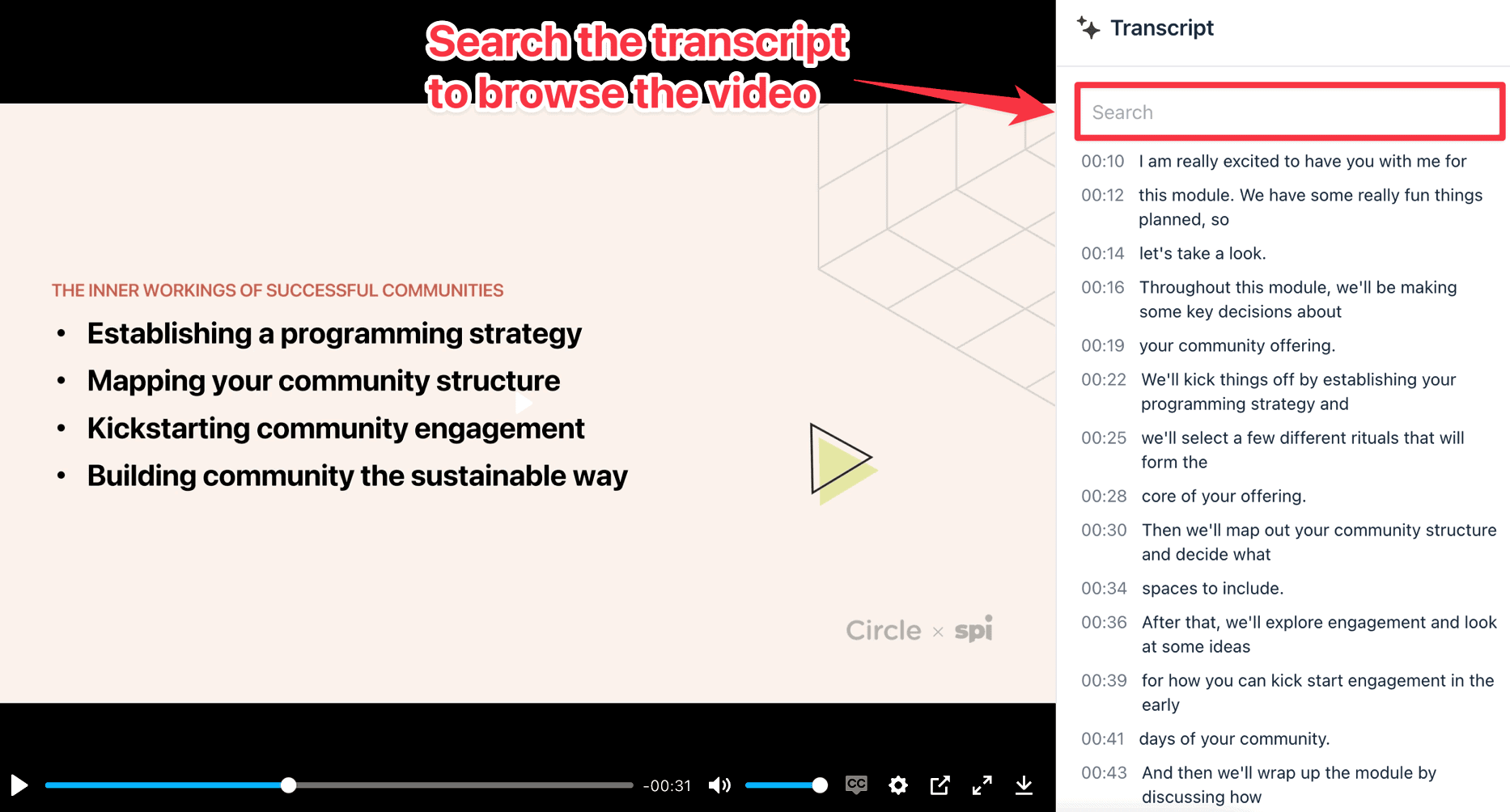
Also Circle has automated transcriptions for videos improving content discoverability in lengthy videos.
This feature allows users to search within videos and easily find relevant sections.
However, with Courses there are some limitations to consider:
- Lack of course compliance features: Circle doesn’t enforce quiz completion, video watch duration, and lecture order.
- No direct course completion certificates: Circle doesn’t offer course completion certificates directly. However, you can use services like Accredible through Zapier integration.
- Limited course engagement reports: Circle lacks advanced reporting to monitor course completion rates and per-student course interaction. It also doesn’t provide video watch retention rates.
👉 By the time you are reading this blog post, there may be additional features that have been rolled out given their substantial funding.
🏆 Bottom line: Circle offers robust course functionality with self-paced, structured, and scheduled learning options. While it lacks advanced compliance features and certificates, the platform provides excellent content creation tools with AI transcription capabilities.
Automation
Workflows
Circle has recently rolled out a workflow automation feature that allows you to set triggers and actions for automating various aspects in your community.

There are up to 20 workflows and 20 bulk action triggers available on the Business plan. Go with an Enterprise plan for unlimited workflows.

There are 3 types of workflows:
- Automation Workflow: Streamline tasks with automated actions based on conditions.
- Bulk Action Workflow: Select a list of your audience members and perform a bulk action immediately.
- Scheduled Workflow: Set bulk actions to run on a recurring basis
It’s like having Zapier inside of Circle.
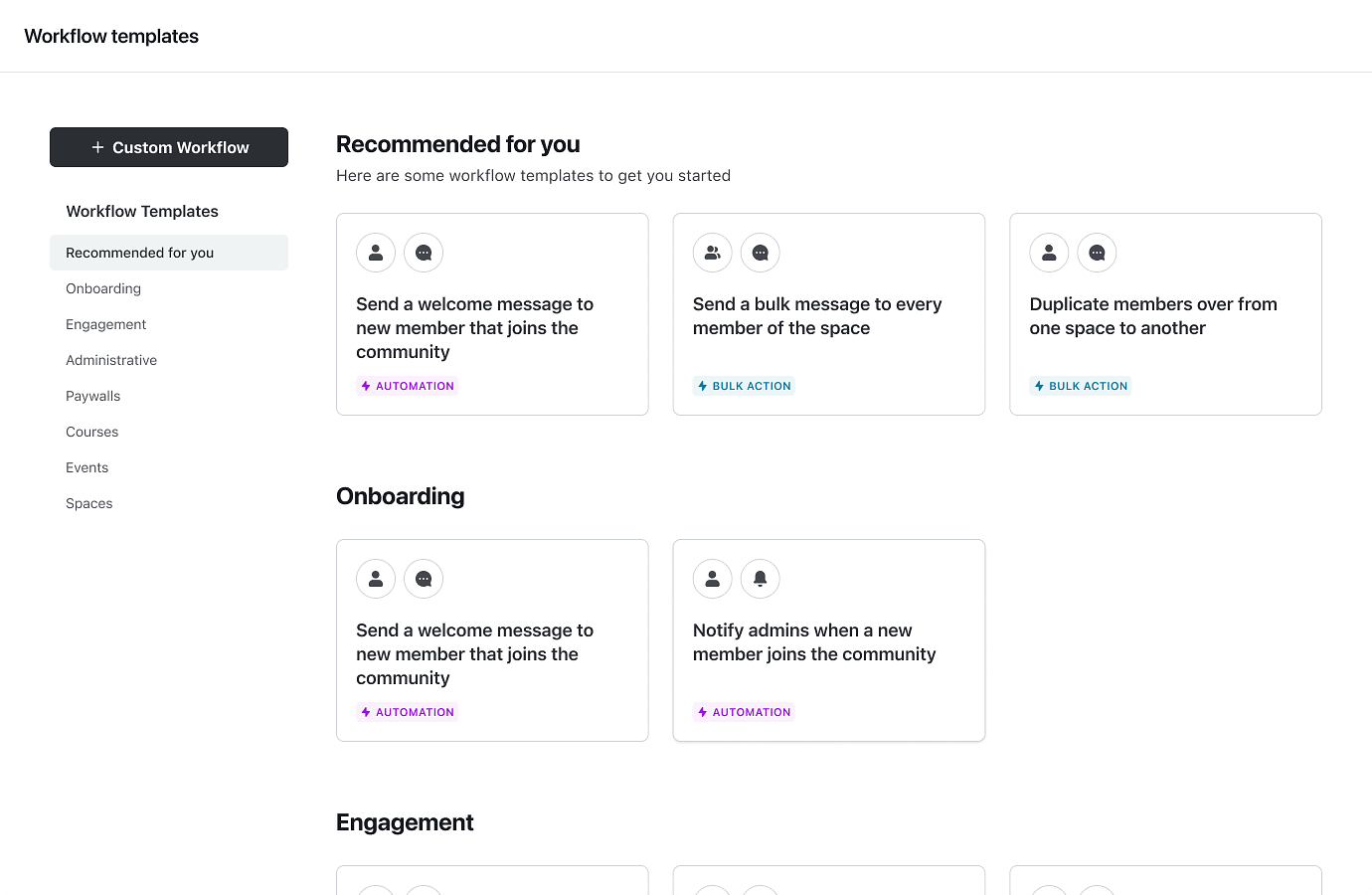
In fact, similar to Zapier, Circle provides different templates to accelerate the process of creating automation workflows.
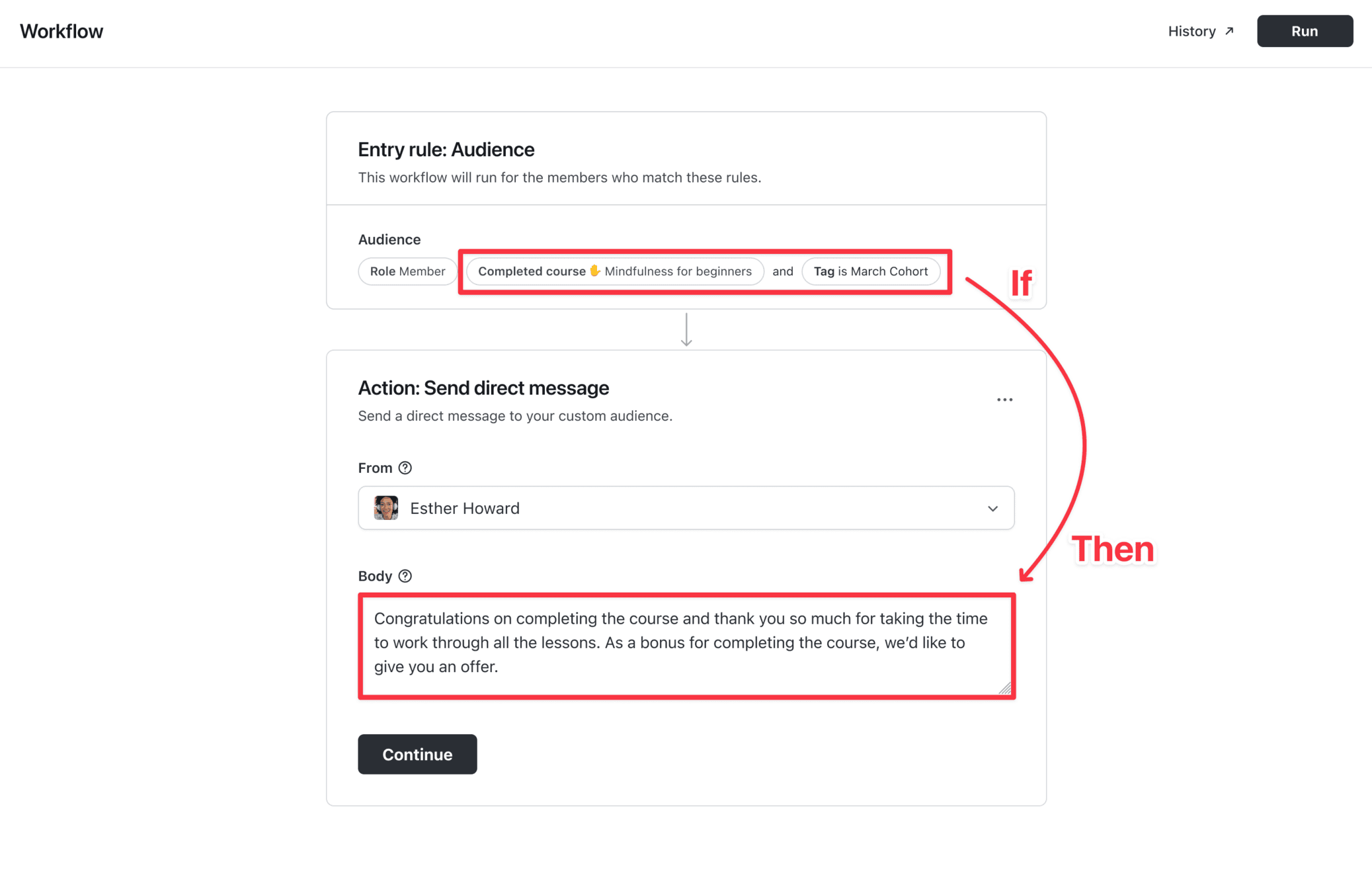
In the example above, you can see that when a student or member completes a course and is tagged with a particular tag.
The possibilities are endless.
Here are a few of the scenarios 🤖 :
- Send a direct message 📨 and add a member tag 🏷️ when a member joins the community.
- Send a message to members 📩 when they RSVP to an event 📅.
- Send a reminder to members ⏰ when an event is about to start.
- Add a member to space 🚀 when a tag is added to a member.
- Remove a member tag from the profile 👤 when a member joins a particular space.
- Add a member tag 🏷️ when a member is charged 💰 for a paywall.
Bulk actions
You can apply filters and select target audience to perform bulk actions on them.

Example: You can add a tag in bulk for all the members who have completed the “Mindfulness for beginners” course.
There are various filters are available to segment your target audience based on their custom profile fields, tags, spaces they’re enrolled in, paywalls, location, event RSVP, last login date, etc.
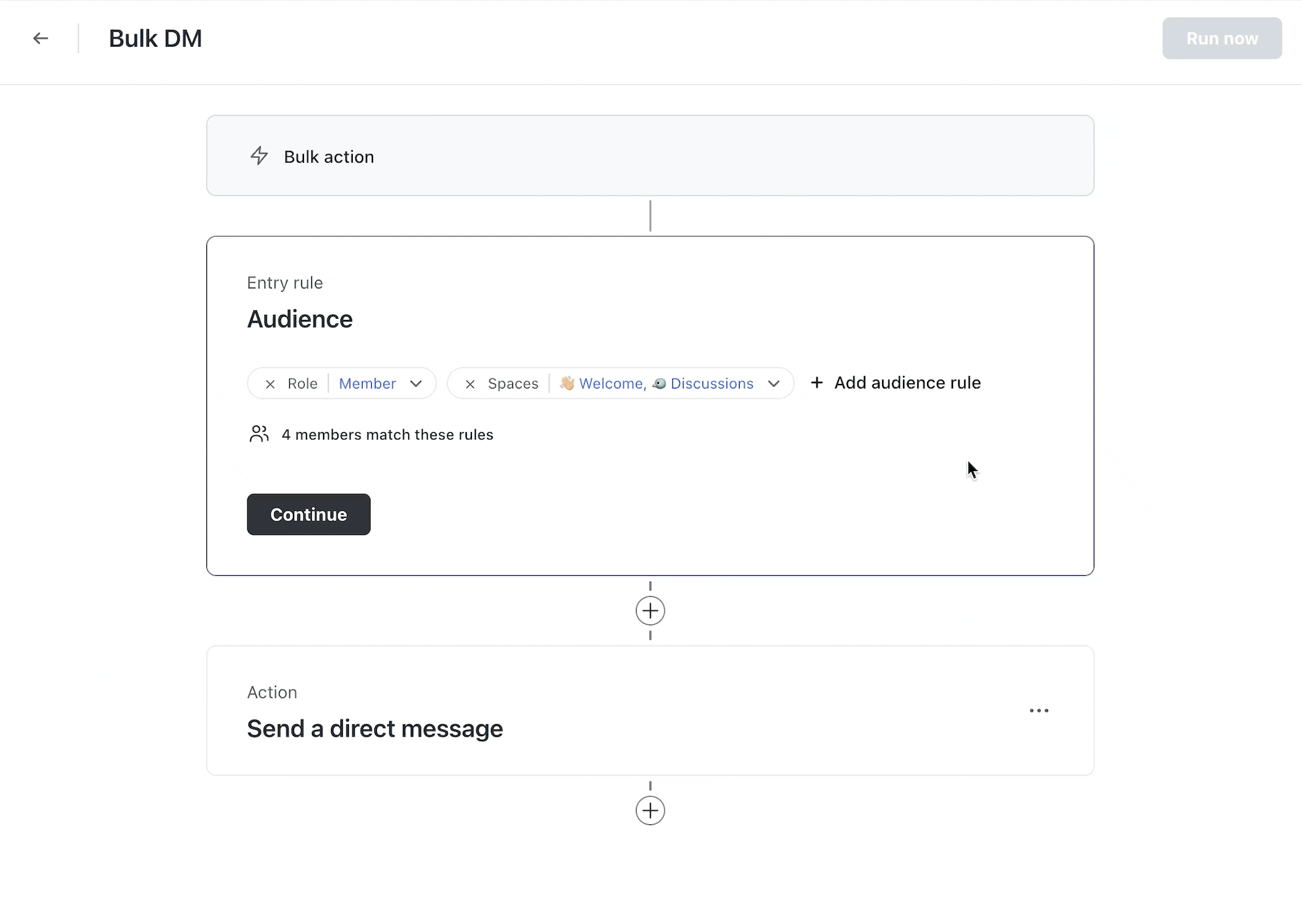
For instance, if community members are offline in particular space(s), then you can send them a direct message.
Here are some bulk actions ideas to maybe set on a recurring basis:
- 🔄 Duplicate space members from one space to another.
- 📨 Send a bulk message to every member of the space (schedule this).
- 👥 Add a member tag to every member of the space.
- ➕ Add members with similar interests to a specific space or space group.
- 🎉 Much more.
🏆 Bottom line: Circle’s automation features offer powerful workflow tools similar to Zapier, allowing community owners to create custom triggers and actions. With bulk operations and scheduled workflows, managing member engagement becomes efficient and scalable.
Gamification features
Circle’s biggest 2025 launch is their comprehensive gamification system, rolled out with Circle 3.0.
Now members can earn points for participating, level up through ranks, and compete on leaderboards.
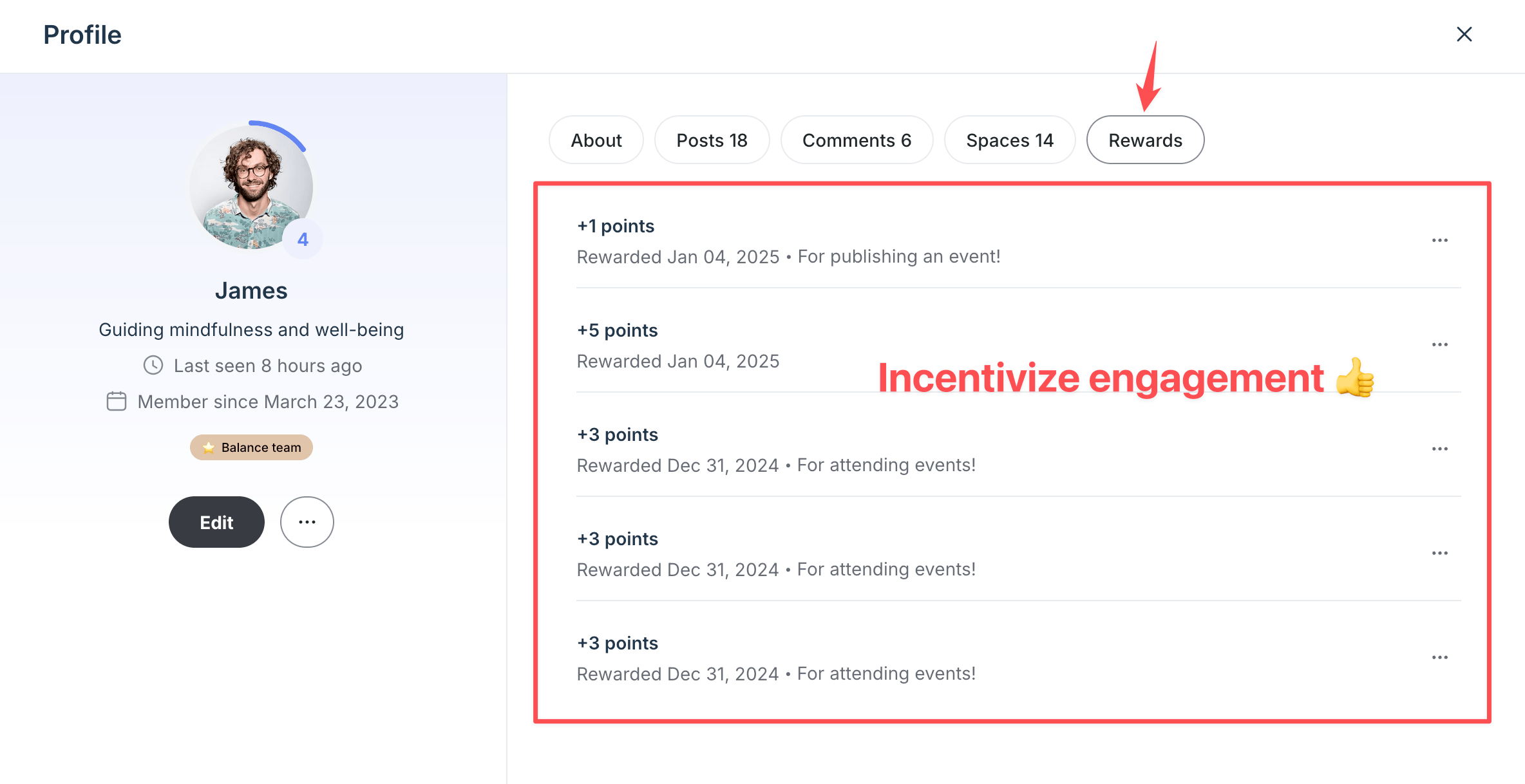
This gamification engine rewards members for answering posts, attending events, or completing assignments.
Community admins can set up custom rewards, trigger automated workflows for achievements, and spotlight top performers.
Here’s you it works:
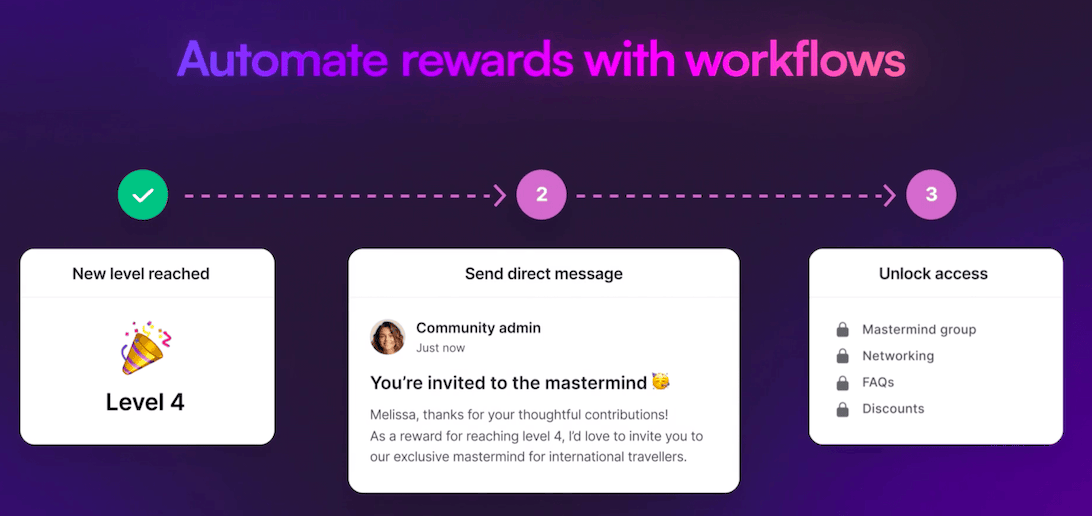
Before this full gamification rollout, Circle was pretty limited in this department.
You would have considered Skool for this.
Also.
It has their Community AI features, including something called “Activity Scores”.
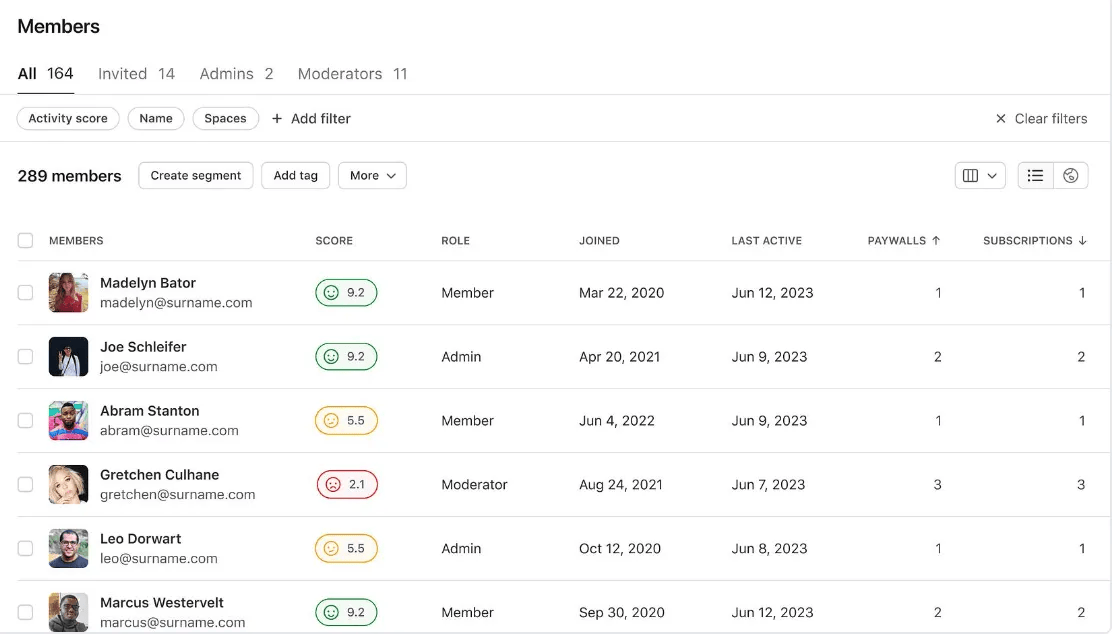
These scores help measure and improve member engagement within the community. Activity scores consider key engagement factors and are benchmarked against data from other Circle communities.
🏆 Bottom line: Circle 3.0’s gamification system makes communities more engaging with points, ranks, and leaderboards. Members get rewards for joining in while admins can create custom incentives and see how well things are working through Activity Scores that compare against other communities.
Website and landing page builders
👉 Personally, I use WordPress with Elementor as I have an existing setup.
With the recent Circle 3.0 update, Circle now lets you build websites and landing pages right within the platform.

You get access to a variety of templates across different niches to choose from, as shown in the screenshot below.
After picking a template, you can customize sections in your landing pages using their pre-made blocks.
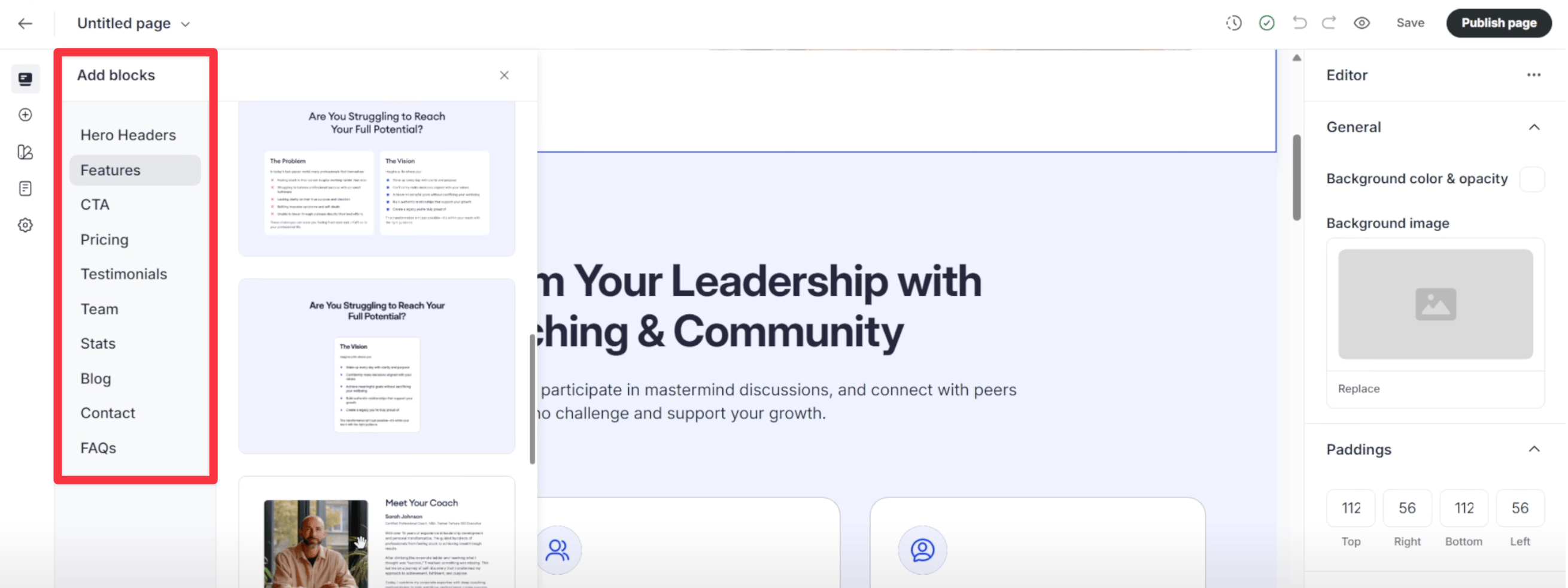
If you’re familiar with WordPress, you’ll recognize the concept of “sections” right away.
💪 Also, they have global style controls which I truly admire and it’s such a time saver. You can update the element at one place and it will get updated in all other places where it’s used. It’s great.
When it comes to the actual builder includes basic elements like paragraphs, headings, links, and buttons.
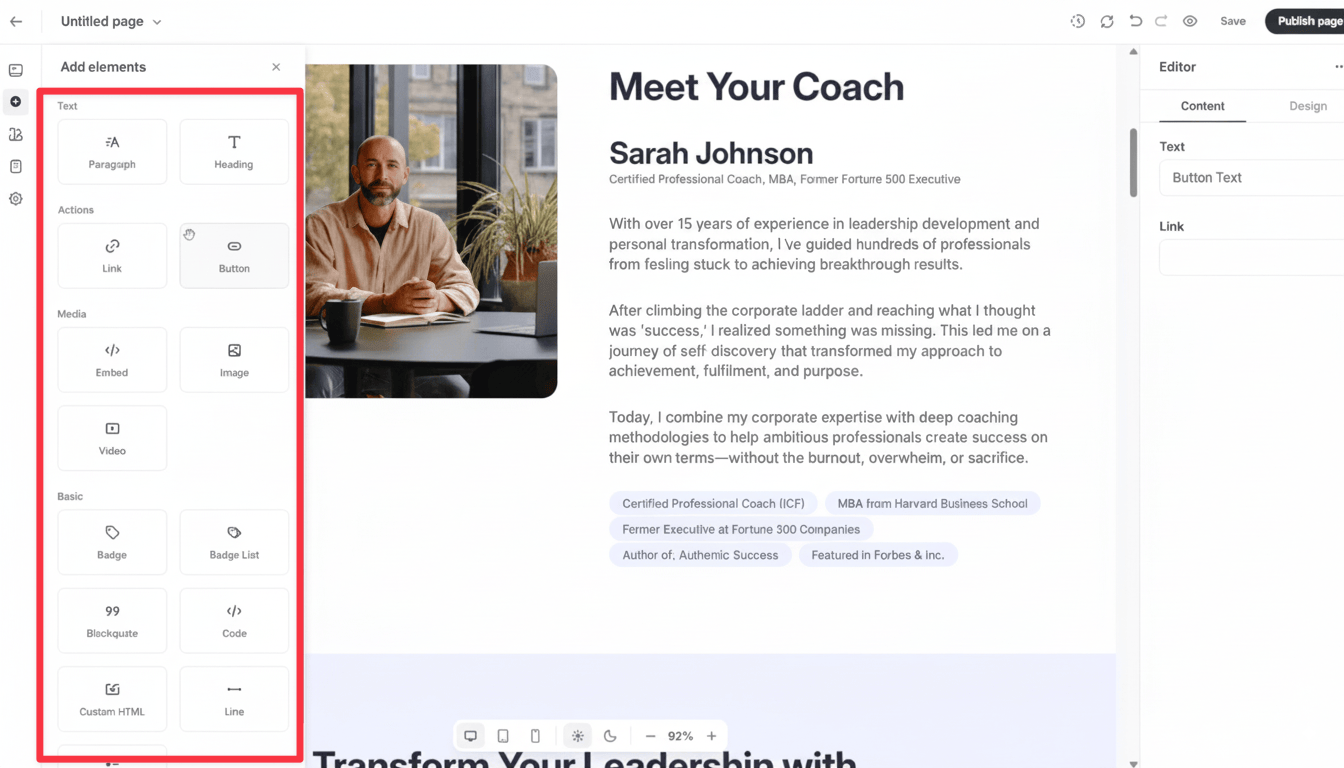
Currently, the selection of elements is somewhat limited, so you can only create simple websites.
👉 One good thing is that they have included a Code and custom HTML widget that helps you include some custom code for advanced functionalities. For example, you can include opt-in forms like from say OptinMonster or Convert Box.
For more advanced design features like parallax effects, you’ll need to use specialized website builders such as Elementor.
Personally, I stick with WordPress and Elementor as I need more functionality.
That said, Circle’s blocks are good enough for creating a decent website without a steep learning curve.
That being said, I would say their website builder needs improvement than Kajabi’s website builder (which has more blocks/elements).
🏆 Bottom line: Circle’s landing page builder lets you create simple websites with templates, but has fewer elements than dedicated solutions like WordPress/Elementor. It’s sufficient for basic needs but may lack advanced design features.
Email marketing
Circle has recently launched their email marketing features as part of their push to become a more comprehensive platform.
With Circle’s email marketing, you get:
- Email broadcasts: Send one-time announcements to your entire audience or specific segments
- Basic segmentation: Target members based on actions they’ve taken, spaces they’re in, or tags you’ve assigned
- Email sequences: Create automated email series that deliver over time
- Analytics: Track open rates, click rates, and engagement
The email editor is also quite simple.
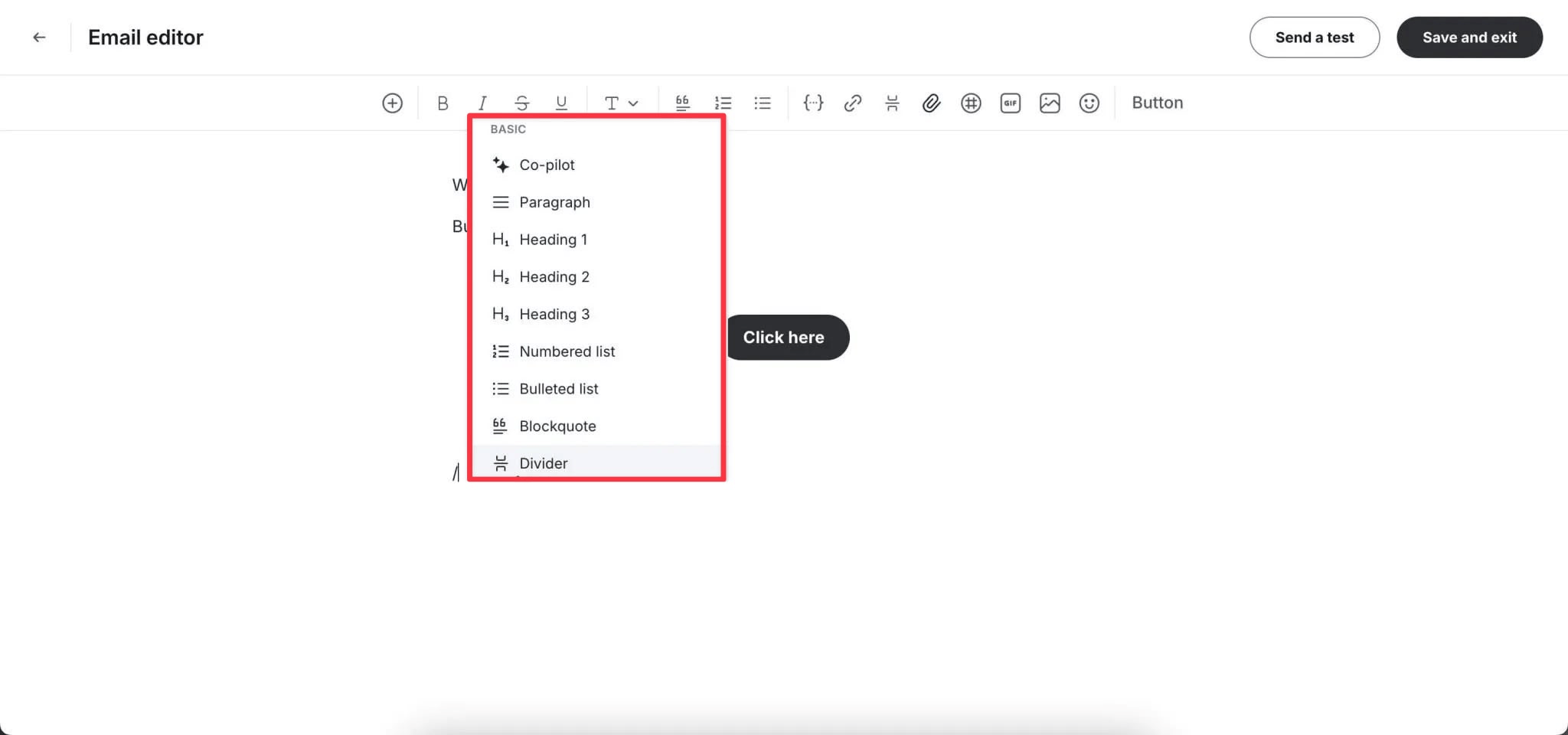
You won’t get fancy templates like you get in dedicated email marketing apps. You get a notion like editor where you can compose your email.
You can include dynamic variables to personalize the emails and stuff.
Here’s the catch though…
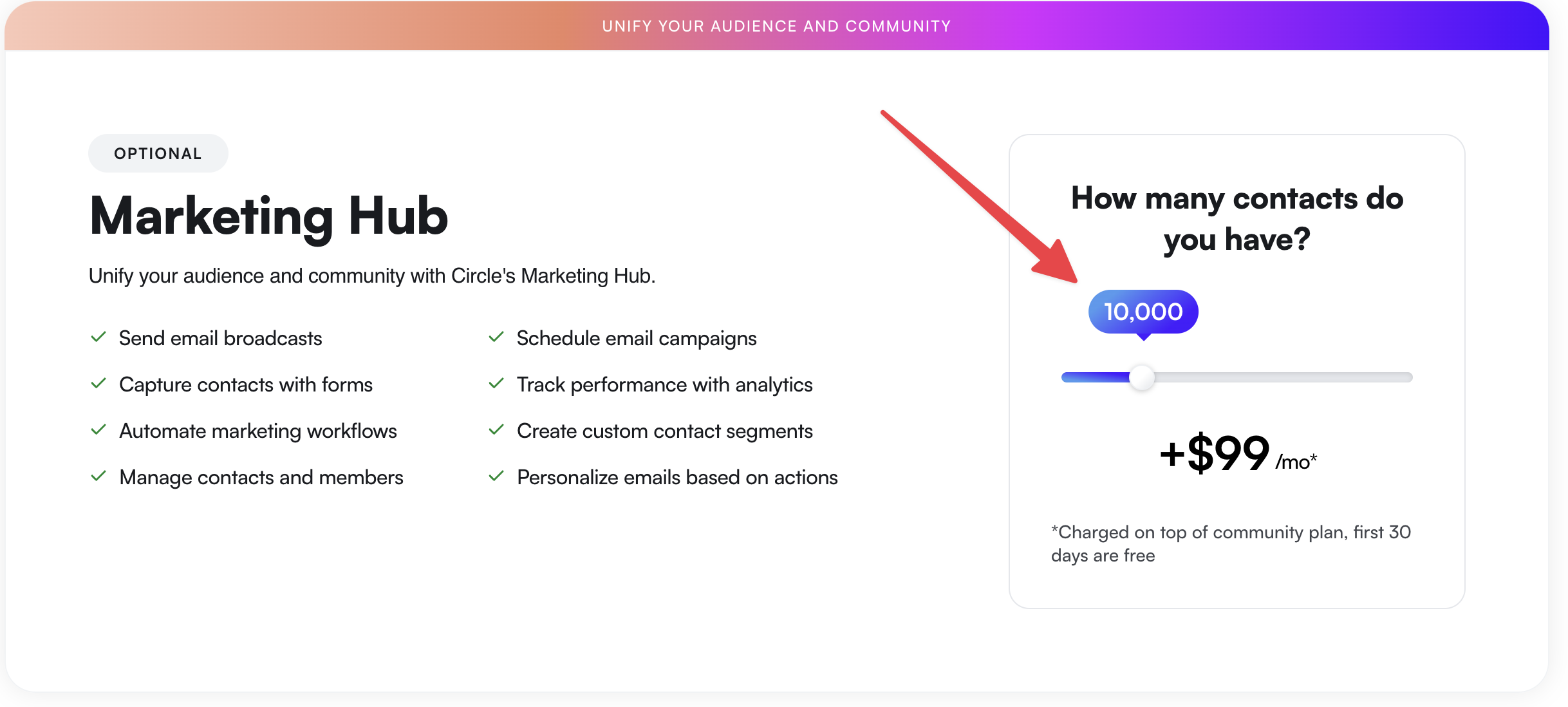
Here’s the reality: Circle’s email marketing costs extra on top of your subscription (Kajabi includes this for free). You’re looking at an additional $99/month for 10,000 subscribers.
And honestly? Circle’s email tools are pretty basic compared to what you’d get with ConvertKit or ActiveCampaign.
You’ll miss features like:
- Advanced segmentation: More granular targeting options based on complex behavior
- A/B testing: Testing different subject lines or content versions
- Deep analytics: The kind of detailed reporting serious email marketers need
The biggest advantage of using Circle’s email is simply having everything in one place – but you’ll need to decide if that convenience is worth the extra cost.
🏆 Bottom line: Circle’s email marketing gives you the basics but costs extra on top of your subscription. While it’s nice to have everything in one place, you won’t get the advanced features you’d find in dedicated email platforms.
Marketing and checkout

Circle offers coupons, discounts, and trials to increase sales. As of now, it doesn’t offer downsells and order bumps.
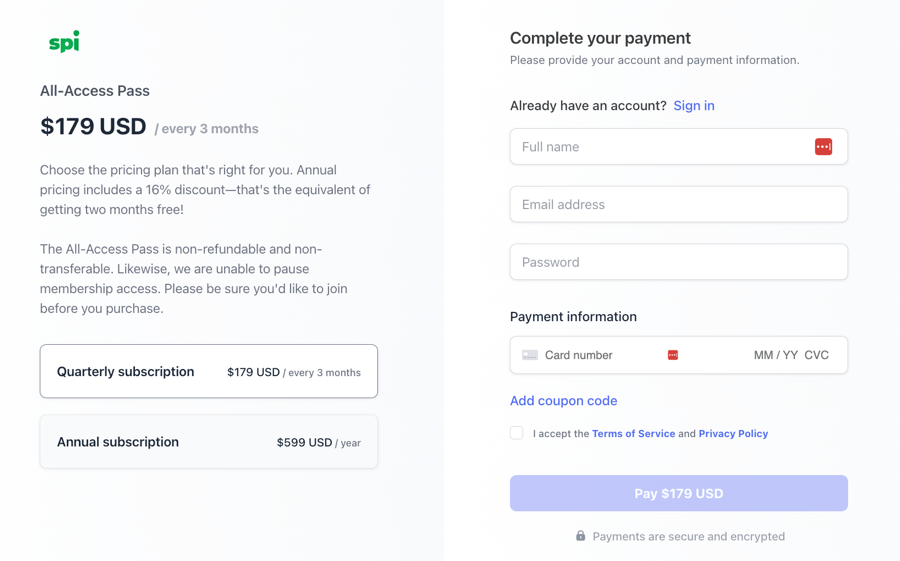
When it comes to checkout, Circle offers a one-step checkout process and only supports Stripe as a payment gateway; it does not support PayPal.
Now, about profit maximizers!
It does not have the option to add order bumps or upsells as profit maximizers.
Additionally, it also lacks the option to add conversion-boosting elements like testimonials and other social proof found in dedicated checkout platforms like Thrivecart or SamCart.
However, if you still need the ability to include upsells and order bumps as checkout features, you should consider integrating Thrivecart with Circle using Zapier or Webhooks.
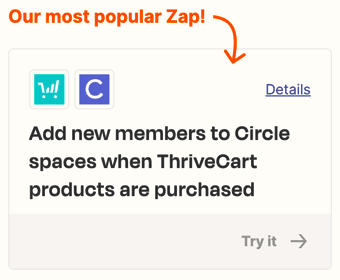
In fact, this use case is the most popular Zap in Zapier.
🏆 Bottom line: Circle offers basic marketing features with coupons and trials but lacks advanced options like order bumps and PayPal support. For sophisticated checkout capabilities, integration with specialized platforms like Thrivecart is recommended.
Mobile app
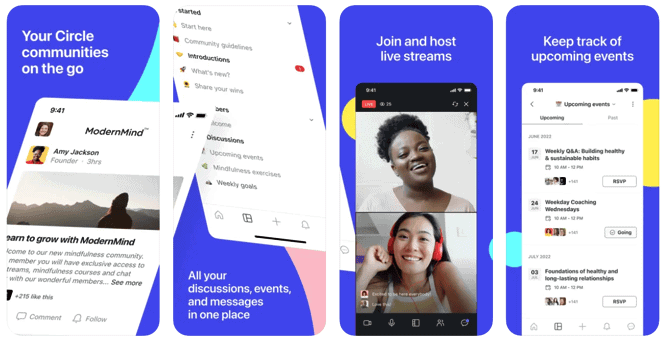
Circle.so has both iOS and Android apps.
Members can access their communities, courses, events, and chats all within the apps.
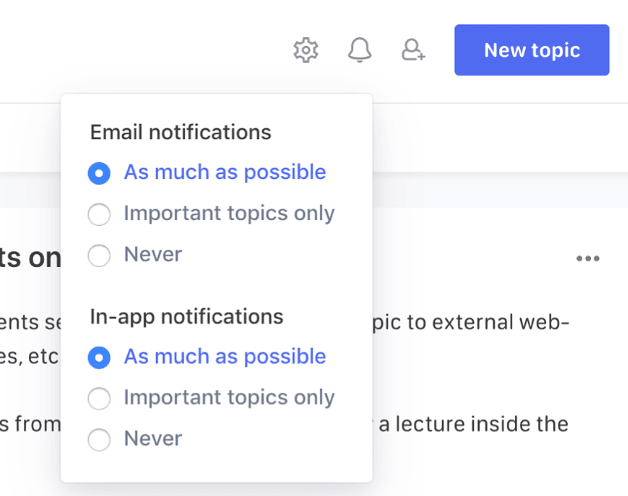
The apps also support in-app purchases and branded notifications, which have better open rates than traditional emails.
One great feature of Circle is the ability to go live directly within the app.
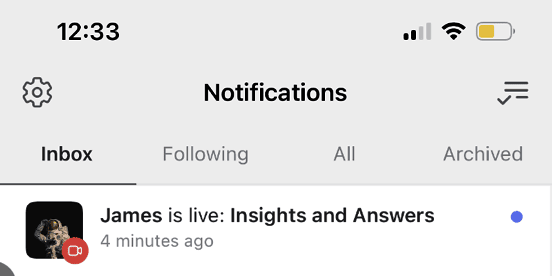
When you go live, all your members will receive notifications, similar to how Facebook sends notifications when your favorite creator starts a live stream.
This feature allows for real-time engagement and interaction with your community members.
To stay updated on all future app updates, you can follow this help guide.
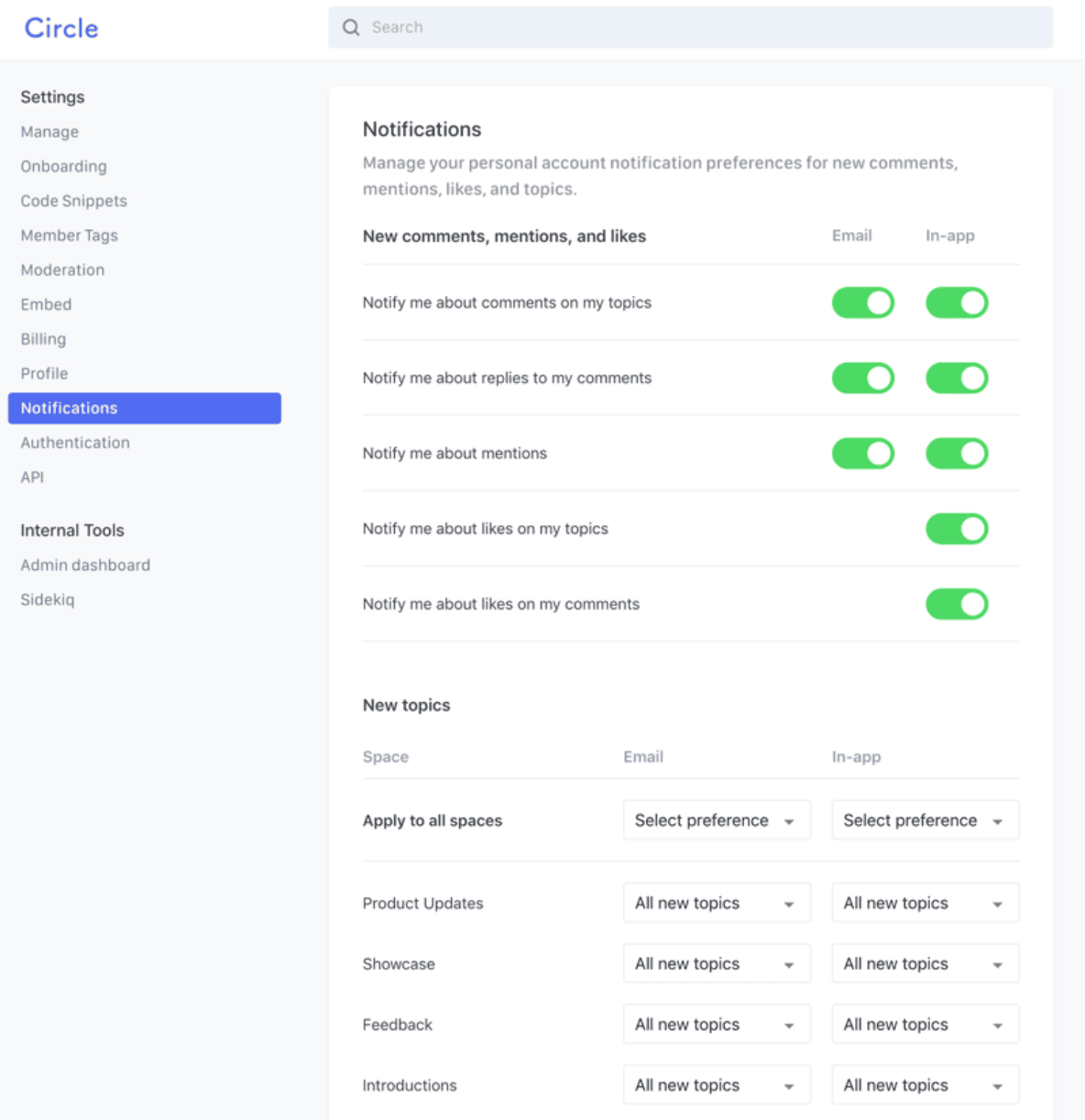
Members can set their own notification preferences either via email or in-app, allowing them to manage updates effectively. They can tailor these settings for each space.
Alongside this, Circle supports event notifications, ensuring members are informed when a new event is published or when they RSVP. To maintain high event attendance, Circle also manages confirmations and reminders.
🏆 Bottom line: Circle has both iOS and Android apps with all the features you need – in-app purchases, branded notifications, and live streaming. Push notifications get more attention than emails, making the mobile experience really stand out.
Integrations
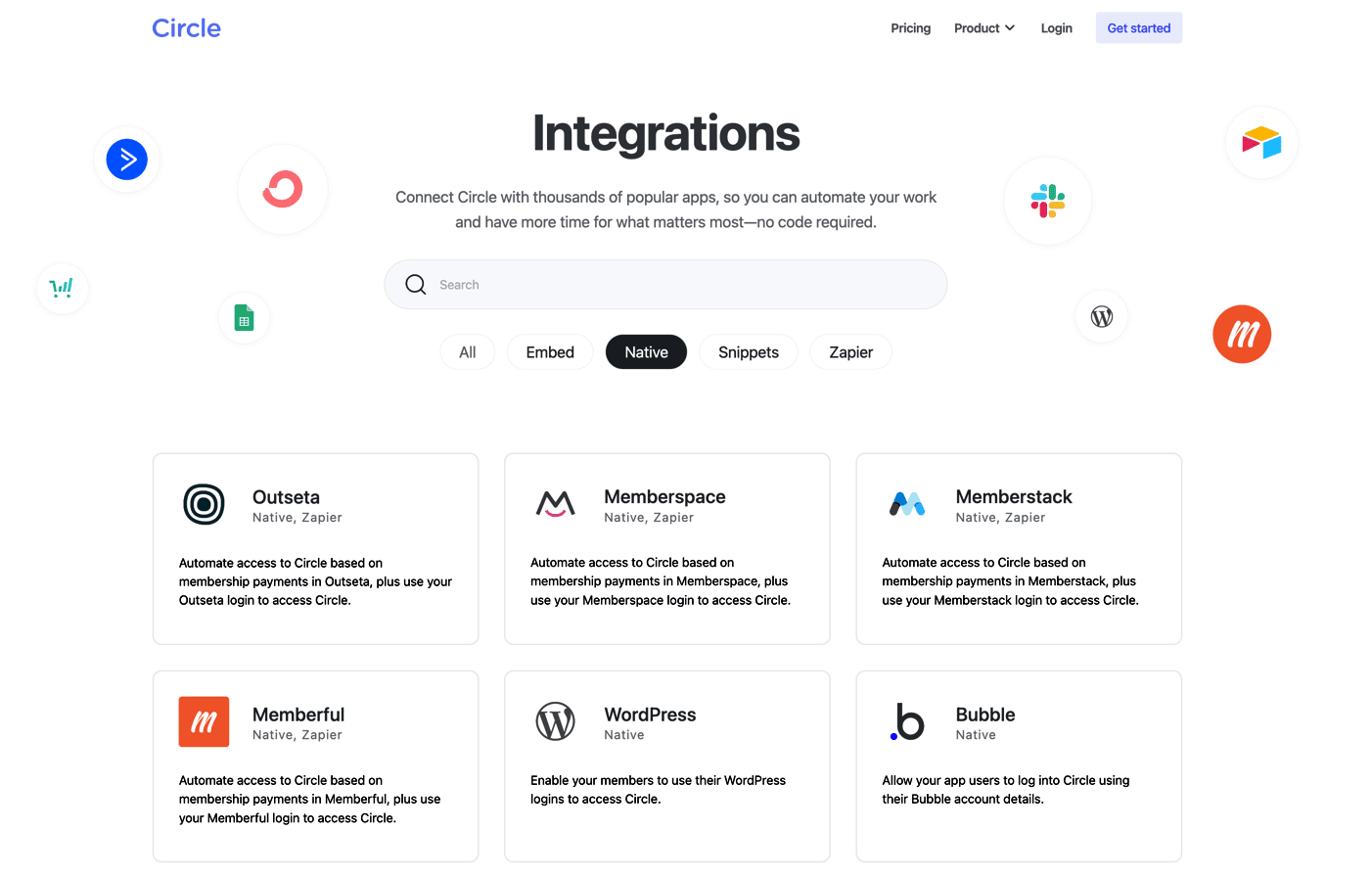
Circle.so offers native integrations with 15+ tools and services.
It provides custom SSO integration with Sendgrid, Teachable, Memberstack, MemberSpace, Memberful, WordPress, Twitter, and more.
For other integrations, you’ll need to use Zapier or their API.
Circle works well with Zapier, featuring 14 triggers and 21 actions.
👎 But oddly, they lack direct email marketing integrations – without Zapier, you’re pushed toward their paid email marketing add-on.
🏆 Bottom line: Circle offers 15+ native integrations plus custom SSO options with various platforms. While it works well with Zapier (14 triggers, 21 actions), it lacks direct email marketing integrations, pushing users toward their paid email add-on.
Circle.so pricing
Circle.so has four premium plans.
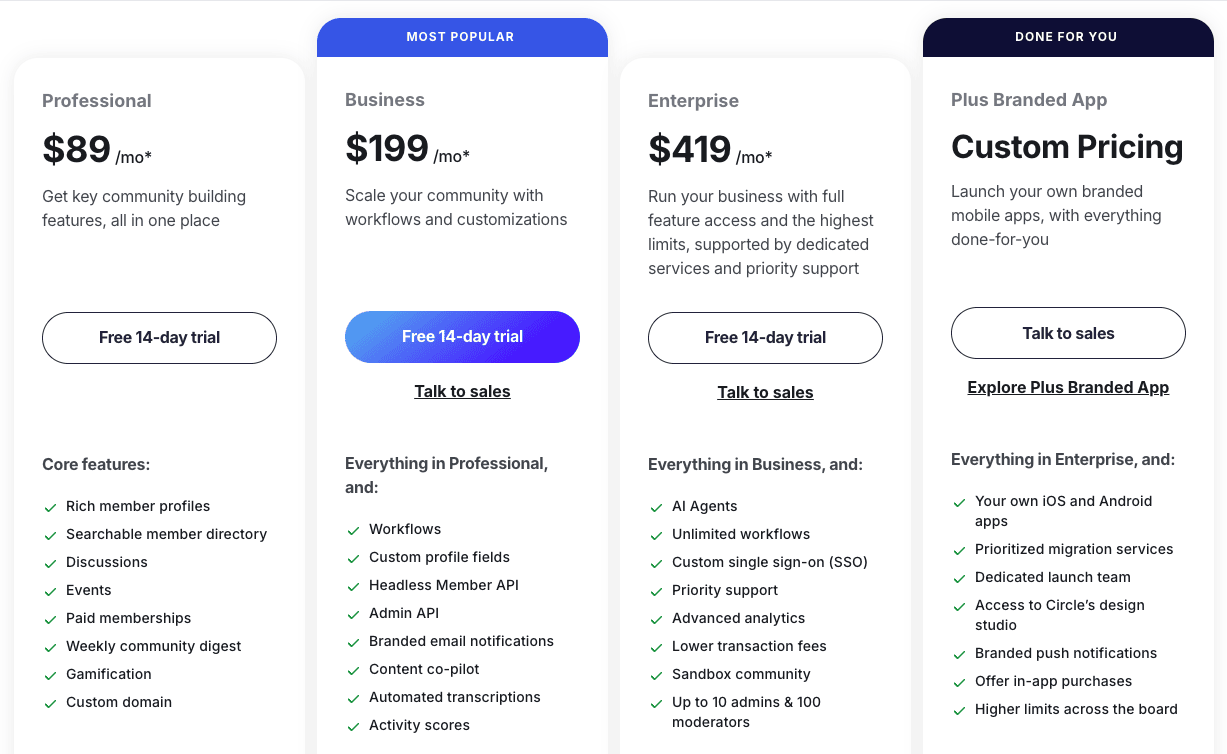
The lowest plan costs $89/mo.
This plan works great for individuals and small creators, giving you rich member profiles, courses, and live streams.
If you need more advanced features? The Business plan at $199/month gives you workflows, custom profile fields, and branded notifications.
3 shady things 🤫:
- All their plans are billed annually (see the asterisk *)
- The transaction fee is not disclosed in the pricing page.
- They don’t clearly mention how many workflows you actually get with their Business plan.
For bigger organizations, the Enterprise plan at $419/month offers full API control, AI agents, SSO, and advanced analytics.
If you feel Circle is not affordable for you, I suggest you take a look at some of its alternatives.
Sign up for 14 days free trial
FAQs on Circle.so
- What is Circle.so? Circle.so is a leading online community platform available today. Along with communities, it also supports memberships, courses, digital downloads, and live streams.
- Does Circle offer a trial to explore its features? Yes. You can sign up for its 14 days free trial and get your hands on the tool.
- Can I get any discount on Circle? Yes, if you choose its annual billing.
- Does Circle have mobile apps? Yes. It has both iOS and Android apps.
Conclusion
Despite being relatively new, Circle is a well-funded community platform that stands out with its clean interface, solid mobile apps, and smart automation workflows.
As I mentioned in my comparison with Mighty Networks, Circle’s features feel more deliberate and carefully designed.
The team ships updates fast and has a clear vision for where they’re headed.
They’re clearly inspired by modern tools like Notion and Slack – and it shows.
That said, Circle isn’t perfect. The course creation features are still pretty basic compared to dedicated LMS platforms. But here’s the thing – the founding team comes from Teachable, so they know what they’re doing when it comes to online learning.
Their goal? To build a true all-in-one platform for creators. They’re not there yet, but they’re moving in the right direction.






